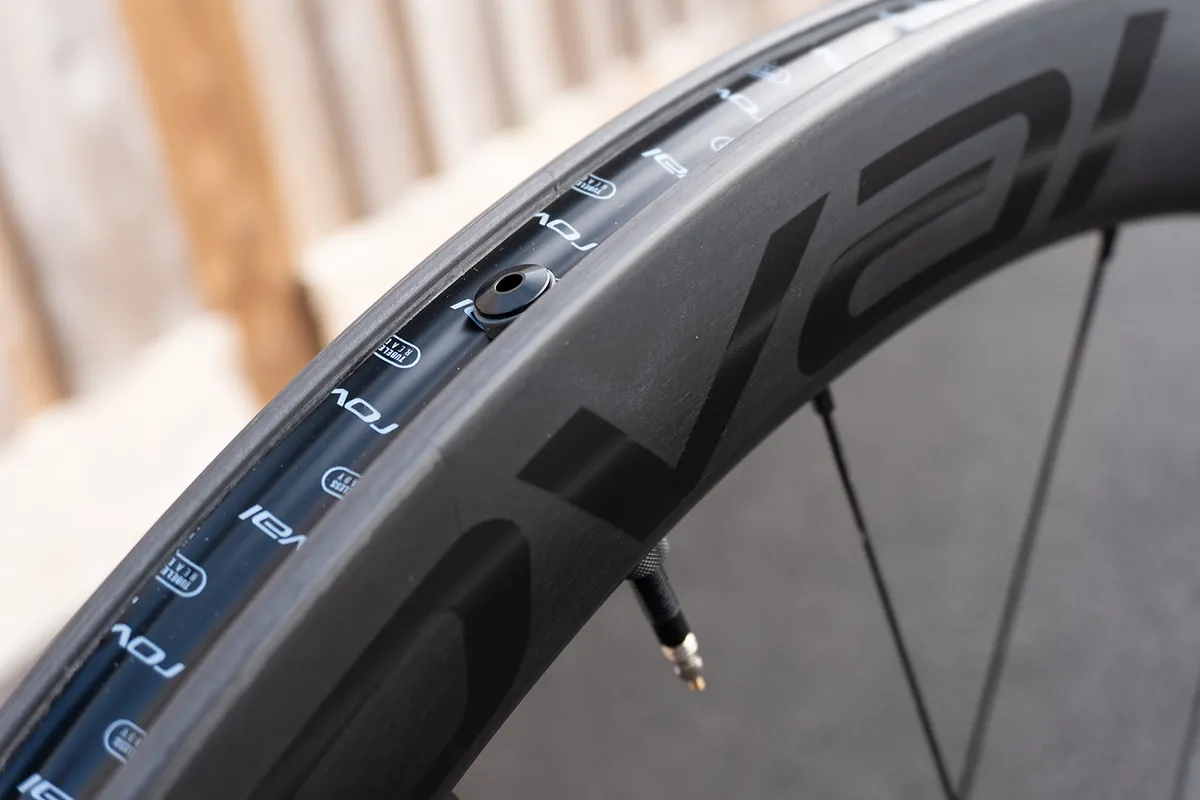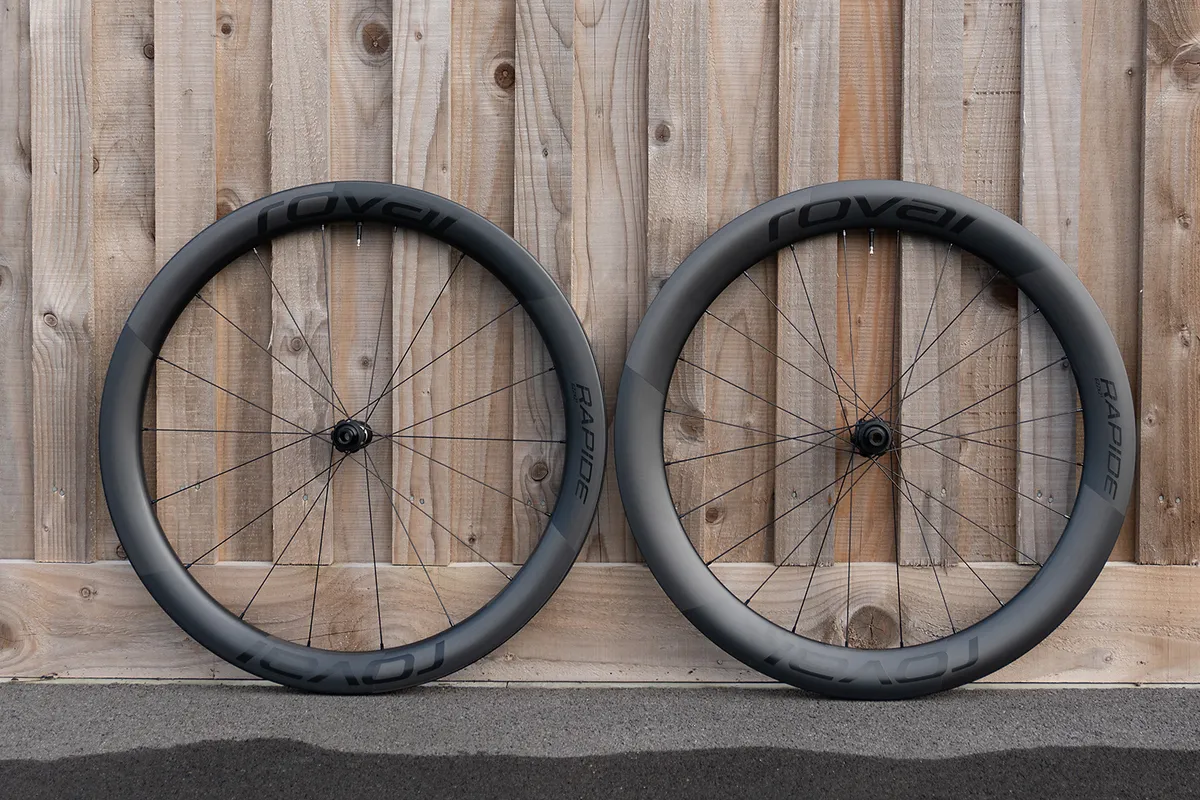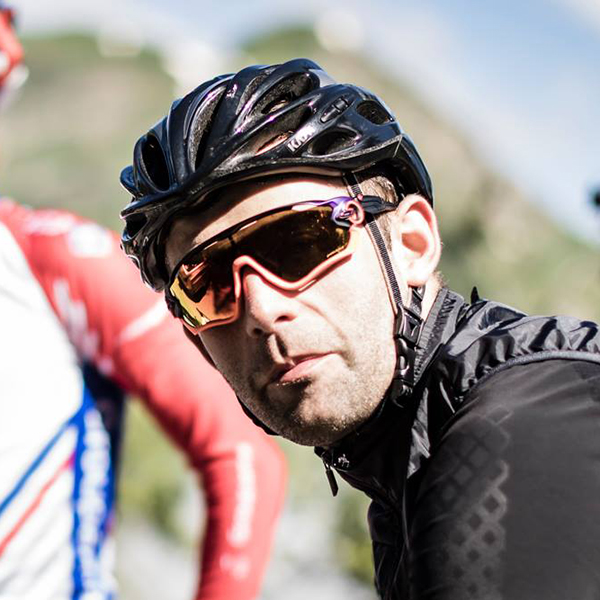Roval’s Rapide CL II wheelset launched in September 2022, and is pitched as the brand’s second-tier carbon aero wheelset.
Underpinning the Rapide CLX II wheelset, it features the same rims with identical dimensions and materials as the flagship hoops.
Where the Roval has managed to save money – to the tune of £1,000 – is in the choice of hubs, spokes and bearings.
This may put off a few riders unwilling to settle for anything less than the very highest-spec components on paper.
However, it’s clear that for the vast majority of buyers, the CL IIs offer more than enough performance to satisfy their need for speed.
Roval Rapide CL II wheelset details and specifications

Roval’s aim with the Rapide CL II wheelset is clear: it targets (almost) the same aero performance as the CLX II, but cuts some of the premium components to achieve its lower price.
Theoretically then, the rims are the star of the show, with each coming out of the same mould as the CLX II rims, and featuring an identical carbon layup.
With WorldTour team Soudal Quick-Step (including its roster comprising Remco Evenepoel, Julian Alaphilippe and Fabio Jakobsen, to name a few) riding on the same rims for most races not held in the high mountains, there’s no shortage of pedigree here.
As with the CLX IIs, the front and rear rim dimensions differ substantially. According to Roval, this means they’re optimised for their position on the bike.
The front rim is 51mm deep, with a 35mm external rim width. The rear rim is 60mm deep, with a 30mm external rim width. Both feature 21mm internal rim widths.
The difference is down to Roval looking to optimise aero performance – not just in the wind tunnel or on its CFD software (although, naturally, plenty of research here has occurred), but out on the road where conditions are far less predictable.
The shallower, wider front rim is claimed to be less susceptible to cross winds: important, given this is the rim that’s far more likely to influence your bike’s handling as a result of such winds. The deeper, narrower rear rim leans more into ultimate aero performance.

Roval thinks this approach is more likely to be faster than using, for example, the rear rim profile for both wheels, thanks to its use of what it says is the first ‘rider reaction time modelling algorithm’.
Theoretically, a rider’s correction and counter-correction for each impacting gust of wind costs speed (and therefore, excess effort to regain it). By using a broader, shallower front rim, Roval says it has minimised this cost without sacrificing much overall slipperiness.
Certainly, when our tester, Josh Patterson, reviewed the Rapide CLX IIs (which, to reiterate the point, use the exact same rim design), he could find little to complain about in this regard.
Roval says you can use up to 700 x 38c tyres, but anything above 35mm-wide rubber should be capped at 60psi.
Otherwise, you can run up to 110psi, with the rims said to be aerodynamically optimised for 26mm-wide tyres.
The rims are tubeless-ready (check out our launch story on the sibling CLX II wheelset to find out why that hasn't been the easiest journey for Roval), with hooked beads that also offer clincher tyre compatibility.
The differences between the CLX II and CL II then start to become apparent.
The hubs are DT Swiss 350 models, incorporating stainless steel bearings (as opposed to Roval’s AeroFlange hub body with 240 EXP internals and ceramic bearings found on the CLX IIs).
Roval confirms that the freehub installed is DT Swiss' latest design, with 36-tooth star ratchet internals, complete with tool-free servicing capability. It’s a tried-and-tested design overall, and well-regarded as a solid base for many wheel builders.
The CL II uses DT Swiss’ straight-pull Competition Race spokes (which feature a round, rather than bladed, profile), with 18 spokes laced radially at the front wheel and 24 laced in a two-cross pattern at the rear wheel.

These attach via alloy nipples at the rim.
Roval says that the wheels should weigh 1,590g a pair, including tubeless valves and rim tape. I weighed them at 1,578g for the set – 12g less than advertised, which is always refreshing to see.
That’s also only 58g heavier than the 1,520g CLX IIs we tested last year. Not bad, when you consider the CL IIs cost £1,000 less for the set.
Roval Rapide CL II wheelset performance

The Rapide CL II wheelset brings brilliant stability to the table, much as Josh remarked in his review of the CLX IIs.
That should come as no surprise because the rims are identical, but knowing Josh’s impressions before reviewing this wheelset, I was still shocked at how steadfast they proved.
I’ve recently reviewed a few carbon wheelsets in the 40-50mm depth range (the Reynolds ATRx and Hunt 48 Limitless UD Carbon Spoke Disc wheelsets stand out). They’re pitched differently, but both are wide and react well to crosswinds.
However, the Rapide CL II is even more impressive, on the basis that both rims are deeper than the 48mm Hunts.
It’s hard to define if they’re faster, but during the few genuinely turbulent test rides when I’ve had the Rovals fitted to my bike, I never missed even the shallower, 40mm-deep Reynolds hoops.
The 35mm external rim width of the front wheel is clearly playing a role here, enabling a smooth curvature of the rim.

Roval says it did its research into optimising the rims to be stable in crosswinds, and it shows.
The rear wheel gets away with its even deeper and slightly sharper profile (thanks to its position). It’s practically unnoticeable that you’re sitting on what even BikeRadar’s chief aero fan Simon von Bromley would describe as ‘a deep rim’.
On flat terrain, the CL II wheelset excels. Once up to speed, it really helps you glide forwards.
The Roval AeroFlange hubs, bladed spokes and ceramic bearings of the CLX II models might further reduce system friction and may (ultimately) be a little faster.
However, I think the CL II proves that such frills are a far higher-hanging fruit than mere mortals like me and most riders (whether racing or simply looking for a speedy ‘Sunday Best’ road bike wheelset) need to be reaching for.
Get out of the saddle and put the hammer down, and the DT Swiss 350 freehub bites fast and enables you to really push forward at will.
There are faster-engaging (and lighter) hubs around than the 10-degree, 36-tooth 350, but unless your cycling success and happiness depends on being able to rocket away from rivals and friends faster than they can react, I’m not sure you need anything more costly.
The CL II is at home on steady and consistent climbs, too, the aerodynamic performance shining through and dovetailing with the sub-1,600g weight well.
Your total system weight will depend on your chosen tyre setup, of course. However, the Rovals are competitive in this regard, just 50g heavier than the Hunt Limitless wheels I had just removed, which featured carbon spokes and shallower rims.
Although not especially attuned to prolonged steep pitches and bergs (you’ll want to look towards the shallower Alpinist CL II wheelset if you really want to excel there), I found their stiffness very satisfying.
Whether standing up or firmly seated, the wheels proved taught and stiff, and an enjoyable platform to test myself on my local hills.
While I’m steadily getting fitter through my winter riding and testing, the seconds I seem to be saving on some of my uphill Strava segments may also be linked to my time spent on the CL II wheelset.
The 21mm internal rim width is bang on trend right now. Although Roval says the tyres are optimised for 26mm-wide tyres, I found my 28c Pirellis (which expanded to a touch under 30mm wide at 80psi) didn’t noticeably hurt the wheelset’s aero performance during testing.
At the front, that leaves plenty of visible rim wall (as is trendy at the moment with progressive aero wheelset designs), while at the back the transition is much closer to being in line.
Tubeless setup
Although my test riding was done with a clincher setup that has remained consistent throughout the UK’s winter 2022-2023 season, I also set the wheels up tubeless.
For this, I picked a set of 700 x 28c Continental GP5000 S TR tyres, one of the best tubeless road tyres currently available.
Both tyres snapped into place with ease, with some vigorous pumping from my cheap track pump, and held pressures well once sealant was applied.
A good 18 hours after initial setup, to my normal tubeless pressures of around 70 to 75psi (with a 28c tyre), they were still inflated and rideable.
That said, a little air top-up was required for optimal pressures, with each wheel having lost around 10 to 15psi overnight. This is par for the course in my experience, though.
The front rim is slightly tougher to mount a tyre onto, given its edges are significantly wider than the rear rim, but I managed it with the help of a single sturdy tyre lever.

I was millimetres away from being able to mount the rear tyre without a lever, but I haven't got a very strong grip, so I daresay someone with more brute force (or perhaps slightly better technique) could manage without.
As far as clincher setup went, I found much the same experience, albeit with the clincher bead being slightly more pliable and therefore a little easier to wrangle over a tight rim.
My one niggle for clincher devotees, though, is that the valve holes are very slightly wider than I usually come across. So when you mount your clincher tyre and fit your tube, the valve barrel can rattle from side to side – a problem you don’t have with Roval’s tubeless valves.
In turn, this leads to a high-frequency rattle when you’re rolling at speed over anything less than an excellent road surface.
For smooth-barrelled valves, this can be solved by tactically applying a small amount of electric tape (of course, barrels with a thread can be fastened with a nut), but it’s hardly a premium solution.
It’s a shame, and almost convinced me to switch to tubeless testing.
Almost.
Roval Rapide CL II wheelset bottom line

Roval has struck upon a great bang-for-buck formula by integrating the centrepiece rims of its range-topping, WorldTour-ridden Rapide CLX II wheels into the Rapide CL II wheelset.
Their speed is obvious, but the stability in windy weather is arguably the most impressive element of the design.
Although you don’t get the very fastest hubs, bearings and spokes Roval can offer, any performance shortfall is small in the grand scheme of things – especially viewed through the prism of a £1,000 saving.
Overall, this makes the Roval Rapide CL II wheelset a compelling choice if you want very fast performance without a (comparatively) wallet-worrying price tag.
Product
| Brand | Roval |
| Price | A$2600.00, €1800.00, £1500.00, $1750.00 |
| Weight | 1578g |
Features
| Rim material | carbon |
| Tubeless compatibility | tubeless_ready |
| Wheel size | 29in_700c |
| Brake type simple | disc |
| Hubs | DT Swiss 350 |
| Spokes | DT Swiss Competition Race. straight-pull |
| Freehub | Shimano |
| Rim depth | 51mm front, 60mm rear |
| Rim internal width | 21mm |
| Features | Axle: 12mm, 15mm thru axles Depth: 51mm front, 60mm rear Width: 21mm internal, 35mm external (front), 30 external (rear) |
| Spoke count | 24 |
| Spoke count | 18 |

